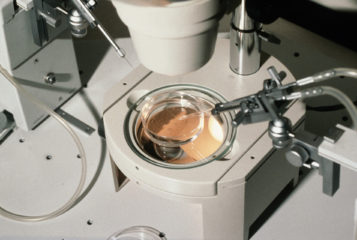This week's BioNews includes the story of a New York woman, Donna Fasano, who was implanted not only with her own embryos, but also those of another woman. The result was a twin pregnancy - one twin being the genetic child of Mrs Fasano and the other child being the genetic child of the other woman, Deborah Perry-Rogers. What has given the story added interest is the fact that the two babies are not only genetically unrelated, but also of two different races.
The mix-up has caused quite a stir in the American press and the reverberations have been felt on this side of the Atlantic. There has been talk of race, of the meaning of parenthood and the need for strict legislation preventing such occurrences. But is it really about these issues?
It must surely be strange and alarming to give birth unexpectedly to what is effectively someone else's child. It must add to the shock when that child turns out to be black. But Mrs Fasano knew what to expect at the birth because the fertility clinic which made the disastrous mistake realised its error soon after the embryo transfer. The fact that the child was black only highlighted the fact that this was certainly not her own child. This is no more an issue of race than it would have been had the other woman's child been white.
Deborah Perry-Rogers and her husband initially decided to claim custody of their genetic child, but they dropped their lawsuit when the Fasanos agreed out of court to hand the child over provided visitation rights were upheld. If the case had gone ahead, there might have been some argument about who the legal mother of the black baby really is. Since Donna Fasano was the birth mother, could she be ordered to give up the child against her will?
As it happened, the Fasanos and the Perry-Rogers were able to come to their own agreement as to the best course of action for the child. They have made the best of a nightmarish situation. But could British-style legislation have prevented the mistake in the first place?
It seems unlikely that even the strictest of rules can prevent stupid mistakes borne out of human error from occurring. The clinic in question will certainly have to answer for its error and the doctors involved will no doubt face legal claims of negligence. But legislating in advance for what are essentially unforeseeable errors seems like a sledgehammer to crack a nut. After all, mistakes happen, even when your every move is watched.
Embryo mix-ups at New York fertility clinic
Image by Alan Handyside via the Wellcome Collection. Depicts a human egg soon after fertilisation, with the two parental pronuclei clearly visible.

This week's BioNews includes the story of a New York woman, Donna Fasano, who was implanted not only with her own embryos, but also those of another woman. The result was a twin pregnancy - one twin being the genetic child of Mrs Fasano and the other child being the genetic...





Leave a Reply
You must be logged in to post a comment.